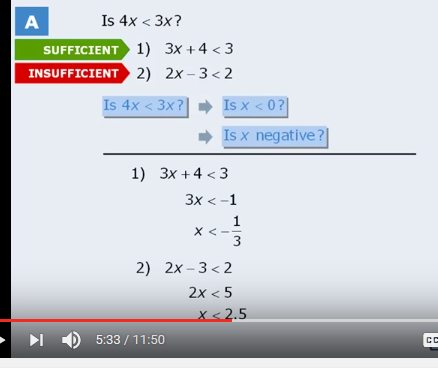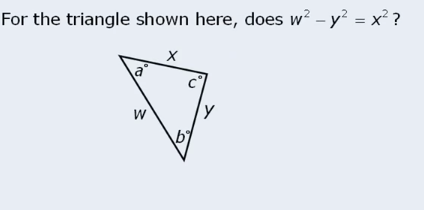Put alarm 2:30 hours.
Data sufficiency overview
Ok so I am gonna tackle all the series of data sufficiency videos at gmatprepnow.com. By the way I like to watch videos at high speed. So I watch usually at 2x speed and find they are still very understandable.
- Important to evaulate each statement independently.
- One very important technique to avoid making mistakes is to write the equation that represents what you are looking for. For example in the question below.

If the equation isnot writen, it is extremely easy to make “silly mistakes”. So I will try to adopt this approach!
Each DS question is either a yes/no question or a value question. For a Y/N question ur objective is to determine wheter the answer to target question is always yes or always no. For a value your goal is to determine wheter there is one unique value that can be deduced using the info provided in the statements.
Now consider this:

Actually I am not in the mood right now, I am distracted because I spent all morning in a bureaucratic process related with the VISA of the country I am in right now, and I know that tomorrow I have a full day of work for something very important I need to prepare.
This is leading me to… 1st, not answer the questions before the video gives the answers…! And this is very bad and very dangerous.
In the question above I actually thought statement 2 was NOT sufficient. Missed something very basic. Definitely this state of mind is not appropriate for studying. I can’t continue like this need to take a little break or a nap or something.
Let me try finish this video. Exercise below:

This one I solved in 2m 6s because I have not yet done inequalities etc. Still managed to find the answer doing the right method… just have to remember that multiplying both sides or dividing doesn’t seem to change the “direction” of the inequality. I remember in high school some operations ( I guess when sign changes or smth) do change the direction. I’ll have to learn those at some point.
Again another question to rephrase wud be “Can the positive integer k be expressed as the product of two integers, each of which is greater than 1?” I thought ok well one thing we know is… is k>4? but I failed to get the deeper point… that if a number is product of 2 numbers greater than 1, then the number for sure WON’T be prime! Again, definitely not sharp now, definitely not.
Same with the next is abs(x) < 1? Well if x was an integer this would mean he is asking if x is 0. But X MIGHT NOT be an integer hence it is asking is -1<x<1 , again, I missed that part, I assumed X was an integer. This is WRONG. Also could have written as … is x^2 < 1? It is EXTREMELY important that I wake up and really start caring about those rephrasings because I can see it is exactly the kind of thing that will come up.
Another example… If x and y are integers and x < 0 , is x^y > 0. Well again I MISERABLY failed to see that even values of y would satisfy the condition.
STOP STOP STOP. I can’t continue like this. I will take a nap, relax and come back in a while. This is counter-productive.
Ok after an hour and a half of napping and rest I am back:
Data sufficiency overview continuing
Ok so main most important point learning so far is that IT IS important to re-frame the question and write a formula if possible to udnerstand what is it that one needs to find. I like this a lot and will definitely do it:
A great example is for example this exercise:

As you can see the question is not immediately obvious. I tried but couldn’t really remember the rules for triangles so couldn’t really solve. I kind of remembered the pythagoras theorem but not fully sure! Actually when you rearrange the equation you realize that they are basically asking is x^2 + y^2 = w^2 which basically is the pythagoras theorem! And that will be the case if angle c is 90. So basically the question is asking… is angle C 90?
There are some more examples but I won’t copy each as anyway most topics have not touched. Now it’s mostly the strategy one needs to remember. I see definite massive weaknesses on geometry etc as I forgot everything. Need to revise that very properly.
Here goes another super interesting example. This one I put because it has to do with integer properties which I have studied:

I need to admit that although I was super close, I didn’t get it right in 2m. I understood the question well, the main problem was that I wrongly assumed that if the integer was higher than 1, then hmmm must have a 2 at least hidden inside. This is stupid. Of course many numbers higher than 1 DON’T have a 2 inside, and the most important thing… PRIME numbers actually only have themselves inside! Which is exactly what this question is asking… is K not prime? Now, I do feel a bit bad I didn’t get this one after all the study of yesterday… but it has help me think for sure and I think it reinforces some of the concepts of yesterday so I am not feeling that bad.
Another example:

This one I did right but took me 3min to evaluate which is way too long. I was honestly expecting some clever method to be able to apply instead of brute force but couldn’t find it so just did brute force. The video also used brute force but with a much much quicker calculation regarding what 4^4 is for example etc.
Another one:

Here I solved well, but again took me 1m 56s to evaluate one statement. I need to be quicker. Little by little !
One more:

Luckily I realized the trick here. I almost almost got it wrong. The key is to understand that when X is positive, this doesn’t mean positive INTEGER. Hence 0.5 can be a value of X hence statement is Insuficient.
Now a MASSIVELY important detail. Check this question:

Now, hmm according to video… in this case if we need to prove YES happens ALL the time, it is not enough by just checkign 5 nums… if truly it is true that YES happens always there must be a mathematical proof. And in this case, although common sense already shows that if I do 0.5 or 1 or 100 it will always be yes, there is a way to actually see it clearly. If one substracts 6x from each side of the equation then we end up with is 0<x (is x positive)? And this is clear that, if x is positive, for SURE always is YES. Hence sufficient.
I need to definitely practive inequalities a lot. They come up so often it seems.
Hence table is good to demonstrate insufficiency, but only good to HINT sufficiency!
Here another interesting example:

Again tried to rearrange. After 2 min concluded sufficient, however some seconds after chosing it, I realized about 1!!! tricky, so its NOT sufficient, which is the right answer. I need to be EXTRA careful. I know the concepts and can see the tricks but need to really be careful. In this case the trick was realizing that when I divide 1 by 5 , the remainder is 1! Because the result is 0 with remainder 1. Luckily I had studied this yesterday.
Another important thing… although true some of these I am takin 2 min, sometimes the answers take 20s or so if extra easy and those I don’t really put here. So even if on exam I go a bit over time, I hope that other questions will help balance. An example of these questions is this one:

This one I solved in 15s or so. Basically my thought process was… k +1 means a number to the right of a prime number. So immediately I thought… most prime numbers are not next to each other, but some are, like 2,3. So testing those 2 already shows that statement 1 is insufficient.
Extremely important when testing numbers not to forget negatives, 0, fractions etc.
Geometry DS
- The picture doesn’t mean anything, don’t estimate from the picture
- To find one length we must be given at least one other length. (This is very important to remember).

For example the image above does not give any length hence we can’t know AD no matter what.
Now this is extremely tough:

I can see how this is complicating quickly . Basically the video says that as both statements together FORCE AB to have only 1 length , and we are given one length, that means we can know the length of AB. Now, no need to calculate it, but we know it can be calculated.
Although I trust this guy etc… I wonder if that length can actually be calculated. Maybe once I do geometry I will find out, but hmm… I will be very confused if I find that even using geometry rules one can’t find the exact value of AB, cause in that case both statements togethers shouldn’t be sufficient right? The question answers what is the length of AB. Hence we should be able to provide an answer. My intuition tells me that yes, there is a way to calculate it, we will see in the future.
Statements can’t contradict each other
This is important to know. Also I see I need to study again quadratic equations, how to factor them etc. It is very important.
Tips
- Do not assume numbers are integers
- Do not assume numbers are not integers. (example below shows how tricky this gets)
Here u can see an extremely tricky question. It would be easy to think that both statements together are not sufficient… but if one realizes that there can’t be 1.9 boys or something like that, one sees that with both statements together, the only number of students that there can be in the class is 10, hence the statement is sufficient.
can see an extremely tricky question. It would be easy to think that both statements together are not sufficient… but if one realizes that there can’t be 1.9 boys or something like that, one sees that with both statements together, the only number of students that there can be in the class is 10, hence the statement is sufficient.
- Real word questions might imply positive integers. Careful (Age etc…)
- Do not over calculate.
- Not all equations with 1 variable x and no powers greater than 1 have just 1 solution. The equation can actually be one in which x can be any number, hence not sufficient.
- Not all quadratic equations have 2 solutions
- Not all equations with 2 variables can’t be solved when other conditions given (when a condition is given , for example x is positive integer, so can’t be 0)
- Before starting to examine one of the statements, look at both 1 and 2 and decide which statement you want to start evaulating first (the easiest one)
Factoring quadratic equations
Ok so I don’t wanna ignore some of the weaknesses so I have started reviewing some stuff. Now one intereting and very useful thing I can maybe use is “factoring quadratic equations” by inspection. Now this only works if the roots of the equation (the solutions) are real. I don’t think GMAT tests imaginary numbers XD so I am assuming I will be able to use this in the exam if required without problem. it helps because it really does help in allowing one to decompose stuff into simpler terms.
The best explanation I have found is this video. Awesome. Love this new skill acquired.
Solving quadratic equations
Also just in case I have refreshed the formula of the Quadratic equation for an emergency if required:

Damn this is bringing so many memories back XD! used to love math in high school.
Ok so dedicated some time to factorize quadratic equations and pretty happy now.
ALARM SOUNDED, And added a bitmore thats almost 3 hours of solid good study. That nap really helped.
Conclusions of Day 3
Today I learned quite a lot about Data Suficiency, this should definitely help for the future study.
Also refreshed quadratic equations and factoring them.
Then most importantly, I re-affirmed that it is pointless to study in the wrong state of mind. It is just a waste. The nap method worked great. After taking the nap I was able to make about 3 hours of very solid study.
Todos
- Improve my brute force multiplying and root skills
- Geometry will be tough, will have to prepare well



